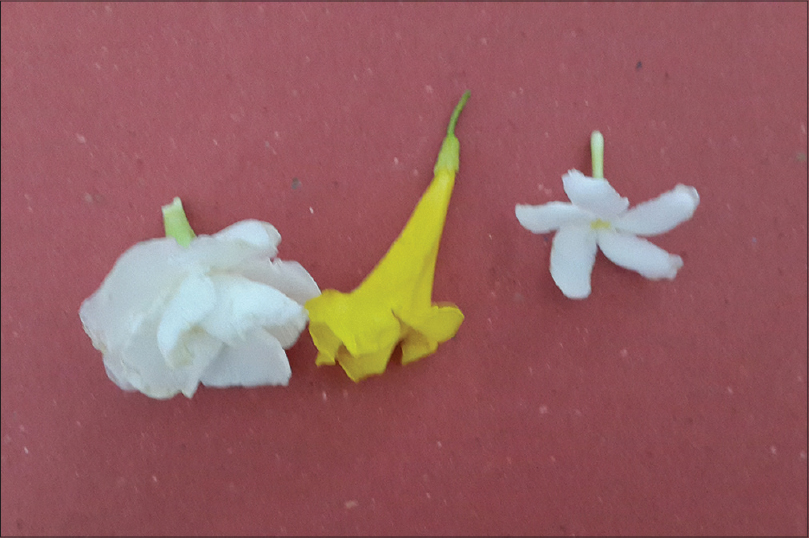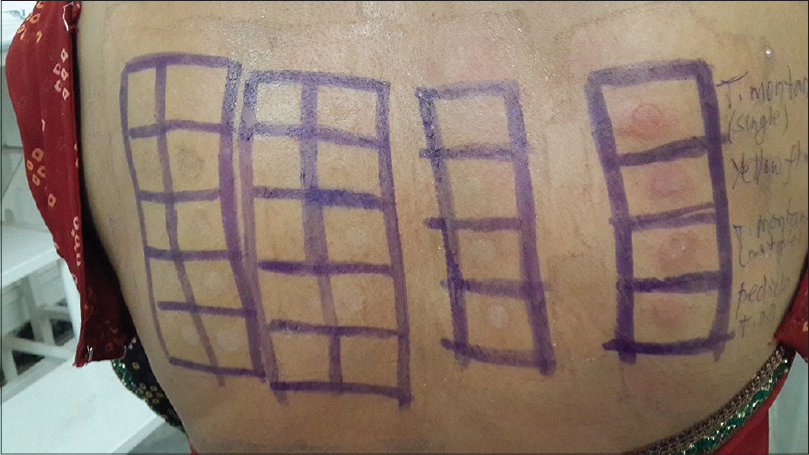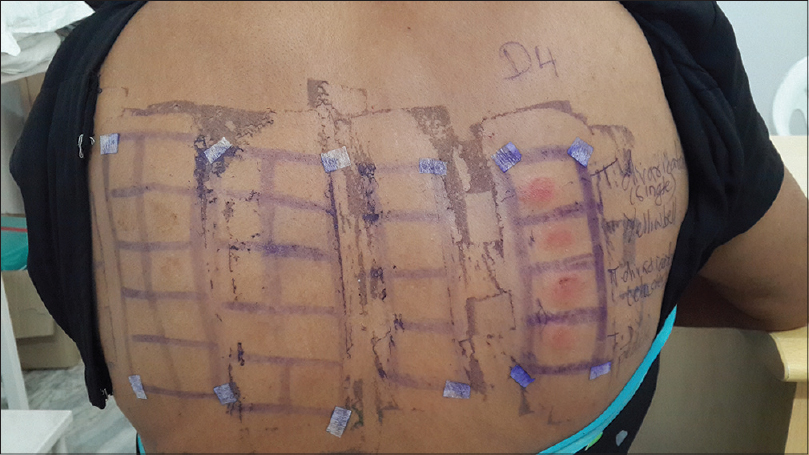Translate this page into:
Fingertip eczema to pooja flowers: Allergic contact dermatitis to Tabernaemontana divaricata and Tecoma stans
Correspondence Address:
Chembolli Lakshmi
Department of Dermatology, PSG Hospitals and PSGIMSR, Coimbatore - 641 004, Tamil Nadu
India
| How to cite this article: Lakshmi C. Fingertip eczema to pooja flowers: Allergic contact dermatitis to Tabernaemontana divaricata and Tecoma stans. Indian J Dermatol Venereol Leprol 2015;81:514-516 |
Sir,
A 46-year-old woman presented with hyperkeratotic eczema and painful fissuring of the thumb, forefinger and third finger of the right hand (her dominant hand) of several months duration [Figure - 1]a and b. Her lesions used to subside with the application of topical corticosteroids, but would reappear on stopping them. Detailed questioning revealed that she was in the habit of plucking certain flowers (crape jasmine and yellow bell) for her daily morning pooja ritual [Figure - 2]. The possibility of allergic contact dermatitis to the flowers was considered and she was investigated accordingly. She was patch tested on the upper back with the Indian Standard Series (ISS) - allergens supplied by Systopic Pharmaceuticals, New Delhi, manufactured by Chemotechnique Diagnostics (Sweden), as well as with the concerned flowers and tubular base. Both the single "pinwheel" form and the double-flowered form of the crape jasmine were tested. These patches were applied using aluminum chambers on micropore tape (Systopic Pharmaceuticals, New Delhi, India) and removed after 2 days. Readings were interpreted as recommended by the International Contact Dermatitis Research Group. Prick testing with the flowers was also carried to rule out type I hypersensitivity, with histamine and saline as positive and negative controls respectively. On day 2, ++ reactions were seen on the sites tested with the flowers and the pedicle of the pinwheel variety [Figure - 3], while the sites tested with the Indian Standard Series showed no reactions. The day 4 reading also showed ++ reactions to the flowers [Figure - 4]. Prick tests using the flowers were negative.
 |
| Figure 1: (a) Fingertip eczema involving three fingers of the dominant hand. (b) Plucking involving contact of the flower with three fingers of the dominant hand |
 |
| Figure 2: The 3 flowers used for pooja- the "pinwheel" and the double flowered form of the crape jasmine (white) and the yellow bell (yellow) |
 |
| Figure 3: Day 2 reading showing ++ reaction at the sites of patch testing with flowers |
 |
| Figure 4: Day 4 reading showing ++ reaction at the sites of patch testing with flowers |
Since using the flowers was part of her daily routine, she was advised either to avoid using the flowers, or to cut them using scissors. She chose to use other flowers for her ritual. Her lesions subsided completely with topical corticosteroids.
Fingertip eczema with painful fissuring involving the dominant hand is likely to be cumulative insult dermatitis, but when strictly localized to the thumb, forefinger and third finger, it points to an occupational dermatitis akin to "tulip fingers" seen in tulip pickers (Tulipa spp. and cultivars, family Liliaceae). [1] Similar reactions are observed in those handling Alstroemeria flowers (Alstroemeria spp. and cultivars, family Alstroemeriaceae), garlic (Allium sativum L., family Alliaceae), and daffodil and Narcissus bulbs (Narcissus spp. and cultivars, family Amaryllidaceae). The diagnosis of plant-related dermatitis may be established by carrying out tests with plant material "as is" or with plant extracts. [2] Chronic irritant reactions may also present as fingertip eczema and need to be considered when patch tests are negative. Patch testing of controls to assess the irritant potential of suspected agents would be helpful.
Floral offerings are an essential component of the pooja ritual, both at home as well as in temples and sacred places. For daily use during pooja, flowers grown in the garden are ideal. The crape jasmine (Tabernaemontana divaricata, family Apocyanaceae), a native of India now distributed worldwide, is a succulent evergreen shrub, with pure white flowers having a yellowish tubular base. There are two forms, the single "pinwheel" form and the double-flowered form [Figure - 2]. [3] About 66 alkaloids (tryptamines, 2-phenylethylamine, ephedrine, aporphines, ibogaine, L-DOPA, protoberberine alkaloids, tetrahydro-β-carbolines, and tetrahydroisoquinolines with monoamine oxidase inhibitor activity) have been obtained from Tabernaemontana divaricata and find use in the treatment of neurodegenerative disorders like myasthenia gravis and Alzheimer′s disease. [4] The exact nature of the allergens is not yet fully characterized, as allergy to the plant or its flowers is very rare. [5]
The yellow bell (Tecoma stans, family Bignoniceae) belongs to the trumpet vine family and is a perennial flowering shrub native to North Central and South America, which is now well established in India [Figure - 2]. This plant has medicinal uses and the flowers are popular as pooja flowers in Tamil Nadu, but contact dermatitis has not been reported. Numerous monoterpene alkaloids, iridoid glycosides, indolic compounds and the novel monoterpene alkaloid, 5-hydroxy-skytanthine hydrochloride have been identified from the fruits and flowers. [6] However, the allergens have not been characterized, as allergy to the yellow bell appears to be very rare. Plucking both these flowers daily for pooja could have resulted in sensitization in our patient. In cases of allergic contact dermatitis to flowers, it is often difficult to determine the exact allergen responsible for the patient′s symptoms as patients may not be interested in further testing with individual allergens. To prevent sensitization to other flowers, using a pair of scissors to cut the stalk would be advisable for those engaged in the pooja ritual at home, temples or sacred places.
| 1. |
Lakshmi C, Srinivas CR. Hand eczema: An update. Indian J Dermatol Venereol Leprol 2012;78:569-82.
[Google Scholar]
|
| 2. |
Lakshmi C, Srinivas CR. Parthenium: A wide angle view. Indian J Dermatol Venereol Leprol 2007;73:296-306.
[Google Scholar]
|
| 3. |
Available from: http://florida.plantatlas.usf.edu/Plant.aspx?id=1924. [Last accessed on 2015 May 30].
[Google Scholar]
|
| 4. |
Pratchayasakul W, Pongchaidecha A, Chattipakorn N, Chattipakorn S. Ethnobotany and ethnopharmacology of Tabernaemontana divaricata. Indian J Med Res 2008;127:317-35.
[Google Scholar]
|
| 5. |
Bajaj AK, Pasricha JS, Gupta SC, Rastogi S, Tripathi SP, Singh KG. Tabernaemontana coronaria causing fingertip dermatitis. Contact Dermatitis 1996;35:104-5.
[Google Scholar]
|
| 6. |
Raju S, Kavimani S, Rao VU, Reddy KS. Tecoma stans (L.) Juss. ex Kunth (Bignoniaceae): Ethnobotany, phytochemistry and pharmacology. J Pharm Biomed Sci 2011;8:1-5.
[Google Scholar]
|
Fulltext Views
4,935
PDF downloads
2,311





